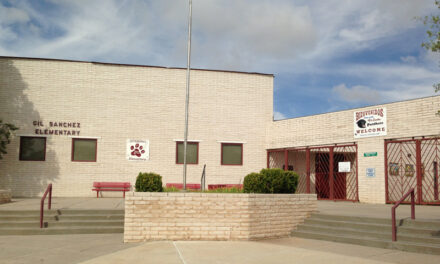BELEN — Calling it “a malady that’s happening across the nation,” a local school district’s human resources director is working to make sure an adult is available to students in the classroom, even it that adult isn’t a teacher.
Looking at teacher fills for the first half of the 2023-24 school year, Belen Consolidated Schools HR Director Tomasita Oshiro reports there have been 2,965 times a substitute was needed in the district across all grade levels — an increase of 437 occurrences than the previous school year. Of those absences, 2,312 — or 78 percent — were filled.
“And 40 percent of those teacher fills (1,200 instances) were because I wasn’t able to get a teacher in the classroom. I’m not able to hire for those positions,” Oshiro told the Belen Board of Education at a recent meeting.
There were 1,765 staff absences during the first half of this school year, which accounted for 60 percent of the need for fills. A “teacher fill” happens any time the district doesn’t have a teacher in a classroom, whether it’s for a full day or part of a day. Teacher fills happen for a variety of reasons, including vacancies, planned leave, professional development, leave granted under the federal Family Medical Leave Act, illness and bereavement.
In that same time period, absences of education assistants occurred 833 times, with 561 fills made, a rate of 67 percent.
In her office at central office is a white board with a list of open positions across BCS — chemistry teacher, math, special education.
Right now, there are 11 long-term substitutes teaching in the district, something Oshiro says is happening because the district — like most other school districts around the state and across the nation — can’t hire teachers.
During the Jan. 23 Belen Board of Education meeting, Oshiro brought board members up to speed on teacher absences and the staffing gaps she has been grappling with since the beginning the school year.
BCS Superintendent Lawrence Sanchez told the board special education positions at all levels have been difficult to fill, as well as openings for math, science and bilingual teachers.
“We’ve had an opening at La Promesa Elementary (for a kindergarten teacher) since the beginning of the year. There’s no interest,” Sanchez said. “So we have to use long-term subs or find other ways to fill that position.”
Oshiro said vacancies in the Belen district and elsewhere are usually due to teachers retiring and a lack of new teachers.
“Colleges aren’t graduating a lot of teachers,” she noted.
Even with retired teachers having to “sit out” only 90 days before being rehired by a district, Sanchez said there hasn’t been a huge amount of interest in returning to the classroom.
“I think we’ve had about five (recent retirements) and I can think of one who came back this year but has since left to pursue other opportunities,” he said. “The interest hasn’t been huge.”
When there is a teacher absence and a substitute isn’t available, Oshiro said the first option is to use personnel called resource assistants, which are basically long-term substitutes assigned to a school site.
“As you can see from the fill rate, they’re busy all the time. The assistants go into the classroom and give support, so they are continually working with students. In the event of any absence, they would go in and give support to another classroom,” she said. “They have their substitute license, so they can sub for any teacher. We made sure we have someone at every site.”
If an assistant isn’t available, an EA will be asked to take the class or it will be split between other teachers.
Clarifying he was speaking as only one board member, board president Aubrey Tucker said he always wanted to see an incentive program for existing teachers.
“Create a rubric that would put teeth into the Teacher of the Year and Employee of the Year. Not a vase or piece of glass. A month’s salary or a full year’s salary,” Tucker said. “That’s how businesses do it. Now, how do we pay for that?
“We are in partnership with those in the bargaining units. Maybe we put up half. NEA is a nonprofit. They pay dues. Why not ask our local or national unions to partner with us for those incentives.”
Board member Jim Danner offered a note of caution to such a plan, recalling a meeting with union representatives where he suggested giving additional money to teachers with high test scores.
“There were so many (metaphorical) daggers I couldn’t get out of the room fast enough,” Danner said. “The chances of that are less than me not eating a tortilla.”
Oshiro said she would be happy to talk to employees to find out what types of incentives they wanted.
“Employee engagement is what you’re looking for. ‘What can we do to show you we appreciate what you do,”’” she said.
Board member Ralph Fernandez emphasized any additional compensation for any district employee would have to be approved by the collective bargaining units representing certified and non-certifed employees.
During a one-on-one interview with Oshiro after the board meeting, she said she is always looking at what she can do to get people into the classroom. It often comes down to how much the district can afford to pay. As a smaller district, with less revenue, BCS is often at a disadvantage to larger, wealthier districts.
“I have to try and compete with Rio Rancho, with Artesia. These districts that have money to do things like give people moving stipends,” she said. “I recently read a report about increasing teacher retention, that one thing to consider is a universal amount for all teachers. That’s not something we as a district can do but the state could.
“It would stop me taking from Moriarty and Moriarty taking from Los Lunas and Los Lunas taking from somewhere else, because everybody’s making the same amount. That’s what happens when you create this competition for limited resources.
“That could give teachers the chance to really focus on where do they want to teach rather than, ‘Oh, I don’t want to be taken advantage of and if I’m getting $10,000 more in Rio Rancho, then why wouldn’t I go there?’”
Julia M. Dendinger began working at the VCNB in 2006. She covers Valencia County government, Belen Consolidated Schools and the village of Bosque Farms. She is a member of the Society of Professional Journalists Rio Grande chapter’s board of directors.

















